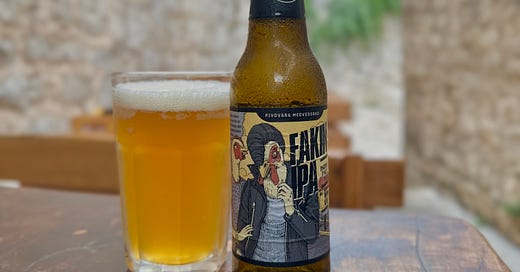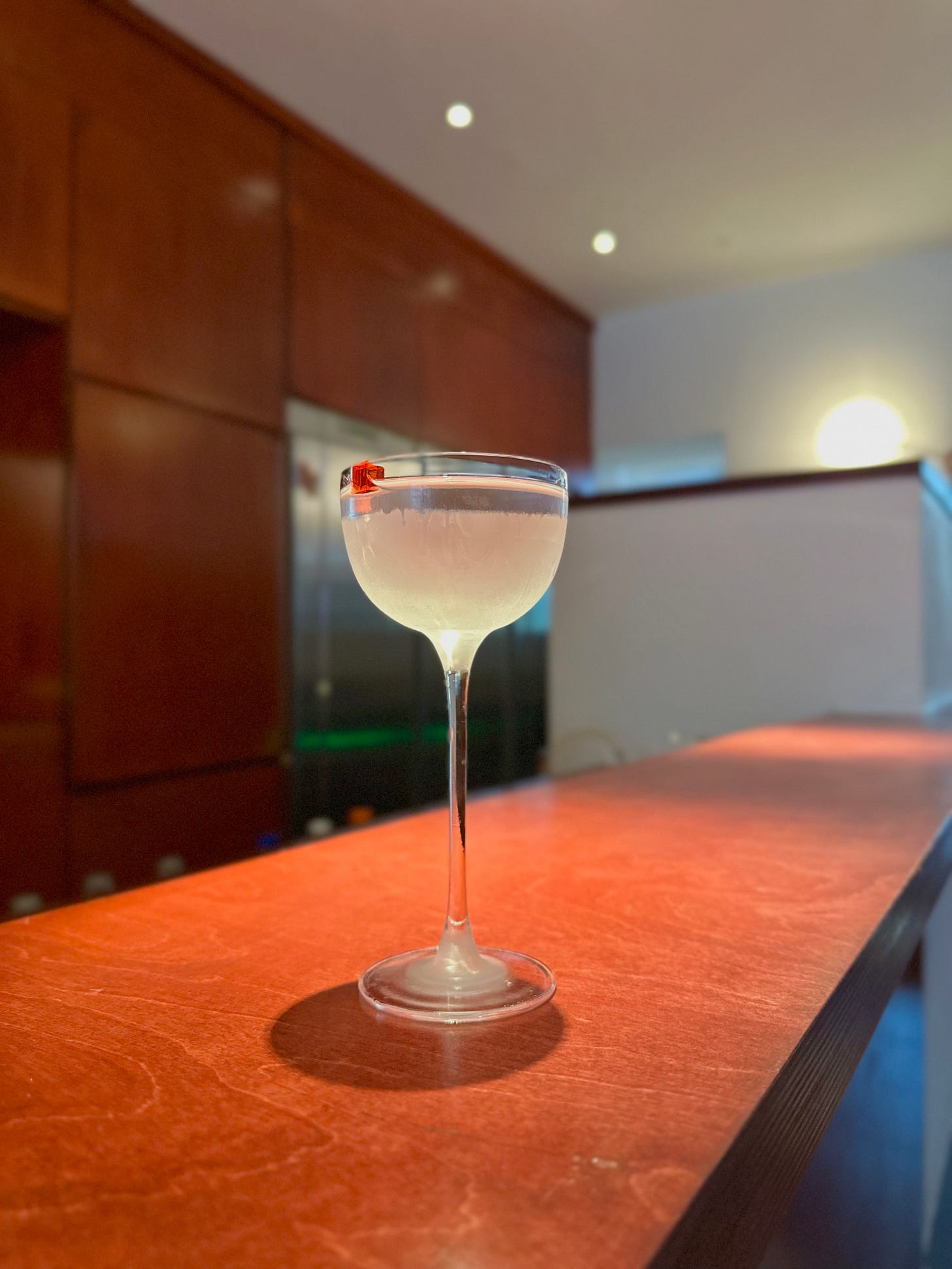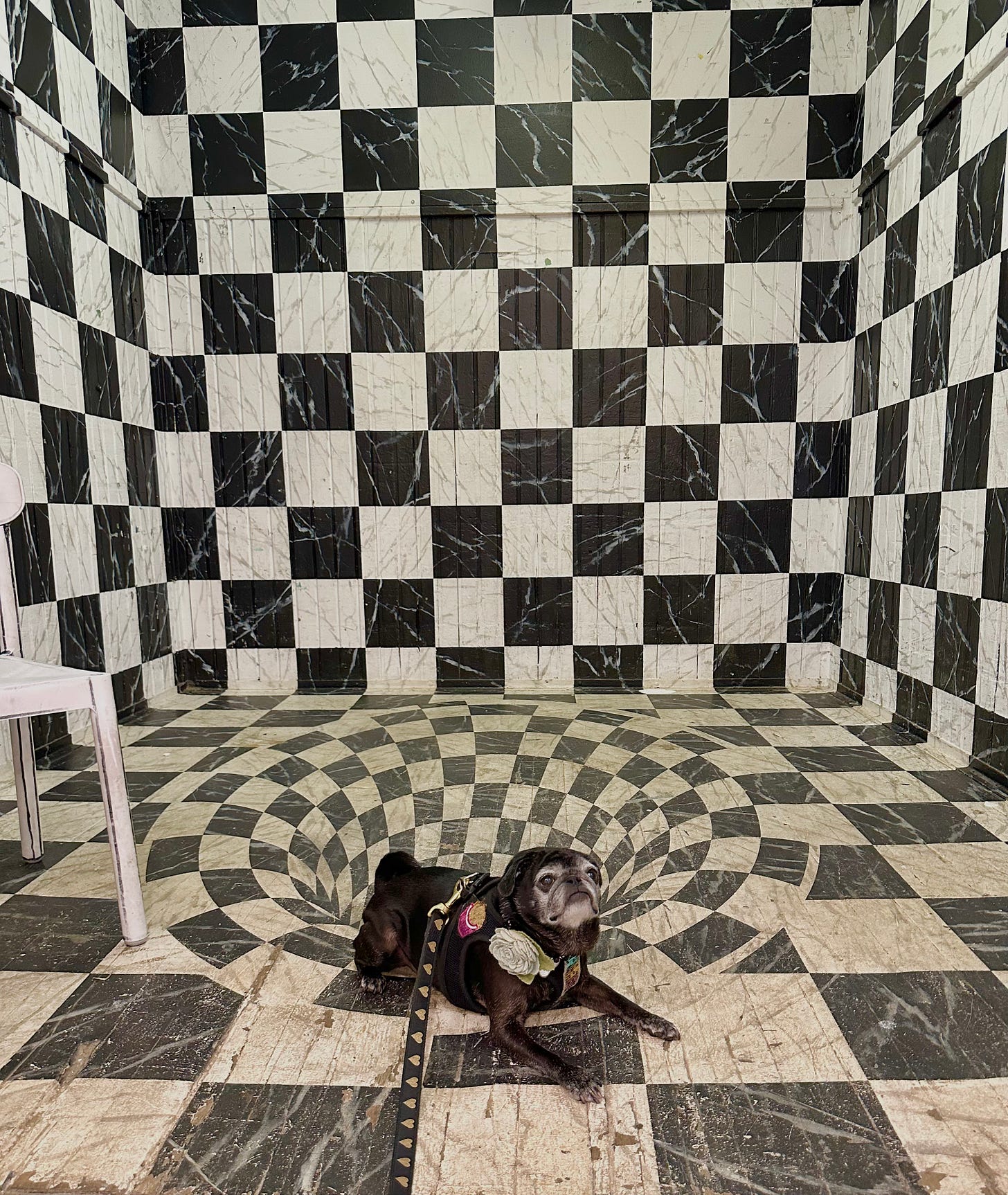106. The Thrill of Craft Beer in Places It's Not Ubiquitous
Drink-fueled travels from London to Croatia and Montenegro; plus tarot for business success and meaningfully taking others along with you.
Mad-Science Cocktails in London, West Coast IPAs in Kotor
Hello, friends. I am writing to you from a beach club in Split, thumping with house music and not all that unlike what I imagine Lindsay Logan’s Mykonos beach club looked like toward the end of its run. It is decidedly not my scene, but this trip has been such a twisty-turny, continuous journey of planes, trains, and automobiles—and boats!—and time zones that I barely know what day it is anymore, let alone how I end up where I end up. I do have a trusty Hugo at my side, which seems to be THE drink of Croatia at the moment. I read that PUNCH piece a few weeks ago and thought, “Huh, I’ve always made myself a version of that cocktail, but have never seen it on menus labeled as such?” Well, I found them. I found all the Hugo’s. They’re all in Croatia. And boy, does St. Germain, prosecco, soda water, and mint go down a treat whether you’re sweating it out in Dubrovnik’s Old Town or lounging seaside in Split.
I have more travel diary for you then this week, because it’s frankly all I really know these current weeks. I think there are some good takeaways here, whether you get drink culture observations or destination inspiration or both. Besides, it’s good to have even one alternative to all-GABF-everything coverage for a minute, right?
After I finished writing the last issue, I had two more drink excursions in London: Wednesday night in Dalston, and Thursday afternoon in Bermondsey. In Dalston, I was after a trio of tip-top-rated cocktail bars. I started at A Bar with Shapes for a Name right when it opened, which proved a good move because it took a bit for the place to start filling up so I got to get acquainted with the very lovely bartenders and really think on my order. (I don’t have to tell you to sit at the bar when going out alone, do I? Unless you’re after some quiet time, of course.)
Bar with Shapes is one of the World’s 50 Best Bars, and their menu, which seems simple at first, along with their penchant for innovation and their above-and-beyond service, solves any mystery why. I’m happy to report this wasn’t even as splurge-y a visit as I expected. I had the Atlas: Redbreast 12 whiskey, amores espadin mezcal, dulce de leche, and tonka. I was worried it might be too sweet for me, but I should have trusted in the delicate balance of this cocktail. It was a tad sweet and caramelly, but also earthy, herbal, woody, and just a touch smoky. The drink, though, that will stay with me forever—seriously, I cannot stop thinking about it—is the Yellow Habanero. They distilled yellow habanero into a spirit. That’s it. And it’s fucking perfect. It, too, was just slightly sweet, with a surprisingly complex heat and spice—but not necessarily *spiciness*, interestingly. And it comes with a Campari jelly cube you eat last, a kind of fun candy dessert that actually cleanses your palate with refreshing bitterness. This is some mad genius-level drinks stuff!
At Three Sheets, I enjoyed an absolutely flawless, satisfying, savor-worthy Foraged Martini—gin, nettle, dry vermouth. Then at Hacha—alongside some delicious tinga tacos—I of course had to try the award-winning, buzzed-about, available-for-sale-on-its-own Mirror Margarita. It was like all the flavors you want from a margarita stripped down and turned up to 11. More tasty science stuff—you can read more about the drink’s origins here.
The next day, I set out toward Bermondsey with one prioritized goal in mind. I had to correct a stubborn error that has long nagged at me, which is that after three separate afternoons spent along the Bermondsey Beer Mile, I had never been to The Kernel. And The Kernel, cries every Beer Person indignantly when I admit this, is the best of all! Look, I don’t know what to tell you—I’m ashamed it took me this long but I have finally righted the wrong. And…all those Kernel devotees were absolutely correct.
A 3AM wake-up call to make our flight to Dubrovnik weighed heavily upon me as I set out on this little escapade. I have been very grateful for 1/3 and 1/2 pints this entire trip, as I’ve been able to try more beers without doing myself a disservice, but I was especially grateful on this afternoon. I tried a rhubarb grisette at The Kernel, bright and tart and just a little funky, and then decided to swing a tad more mainstream with a Mosaic IPA, an American IPA take that nicely featured Mosaic’s peachy, mango, pine notes. On the way out, I was extended the very kind offer to try a saison with Mosaic they were working on, which kind of felt like this perfect blend of both sides of the beer equation that The Kernel clearly does so well: a more traditional style, and a more contemporary update with plenty of hop character.
I swung by Cloudwater and tried a West Coast IPA, which was, perhaps unsurprisingly, quite good. Several years ago, it felt like the thing to try to see where another country’s craft beer scene was in relation to America’s was a hazy; this trip, I sort of accidentally made it a West Coast IPA and then happily stuck to it—I didn’t come across any I didn’t like and didn’t think represented the style really well. I finished up this mini-trek with an Oktoberfest lager at Anspach & Hobday that made me so excited for fall.
24 hours later, I was drinking the first of many Hugo’s at our hotel in Dubrovnik. The beer scene, and drinks scene in general, has been quite different in the Balkans, to say the very least. For starters, despite our destinations Croatia and Montenegro’s positioning on the Adriatic Sea, I hadn’t anticipated what a spritz-forward situation this region would be. It’s giving Italy, sans try-hard influencer vibes. In addition to the Hugo and naturally the omnipresent Aperol Spritz, it feels like nearly every hotel, restaurant, and bar will throw together any combination of aperitif and botanical to make something ridiculously refreshing and delicious. I’ve admittedly felt very “beer who?” vibes indulging in some of my favorite flavor combinations here, from Campari and mint to limoncello and lavender—Croatia is known for its lavender, especially on the island of Hvar, where so many stands line the streets selling it that the streets smell of it and it’s all very dreamy.
But, what about beer, here anyway? In Dubrovnik, Split, and Hvar in Croatia and in Kotor, Montenegro, as I sought out the two-or-three craft beer bars in town, it took me back to the American craft beer scene in, say, 2009. Think of your smaller, non-craft-beer-capital cities around then. There was maybe one brewery taproom, two or three brewpubs/beer bars/bottle shops? And some other bars and restaurants might have had one or two craft beers on tap, but it certainly wasn’t a guarantee, and plenty had no craft representation at all.
What this fuels is more excitement at the places that do specialize in craft beer, more passion. There’s still a thrill of the hunt in this kind of craft beer environment, which is obviously long, long gone in the US, perhaps to such an extreme that it’s detrimental to breweries. And you quickly become so much less jaded in a scene like this—in Hvar, for example, I visited Hvar Brewing Co., and there were just three beers on tap that were their own, a pilsner, a session IPA, and a sour. This would be quite a rare arrangement in an American taproom, and plenty of beer geeks would balk at the lack of selection. But in Hvar, you’re thrilled to have a well-made craft beer to sip on a seaside patio.
In Dubrovnik, we popped into the Dubrovnik Beer Factory, a rough-and-ready garage-y pub tucked into one of the Old Town’s tight alleyways, an atmosphere similar to what I’ve found at craft beer bars in places like Prague. Here, too, the main-attraction craft options were a trio: an IPA, a pale ale, and a lager from Dubrovnik Beer Company. While the very nice bartender ended up regaling us with the kind of hammered-customer horror stories that unfortunately come with a tourist-oversaturated place like Dubrovnik, he still maintained an excitement free of cynicism about the beer itself. Which is impressive, when you’re dealing with things like crying men dressed as Smurfs for a stag do.
We found a similar story in Split. On the (luckily!) lone wash-out-weather day of our trip, we found the one brewery taproom nearby. A few men sat alone drinking espresso and smoking. Again, three beers: an IPA, an APA, a pilsner. Our expectations were admittedly low as my friend and I both ordered the IPA. And said expectations were shattered by how absolutely perfect the IPA was. Following a trend I noticed in this part of the world, it was an “American IPA,” a harmony of West Coast piney, resiny bitterness and New England tropical and citrus notes. Soon, there was a bartender swap, and the extremely friendly and personable Lucia told us excitedly, “You know, we make the beer right here!” She took us back to the brewhouse for an impromptu tour, beaming with pride for her place of work. It was…awesome—genuinely cool to see someone both clearly being treated well at their brewery job and who is utterly psyched about working with craft beer. There is still a palpable buzz surrounding the bubbling up of craft beer there.
Two spots stood out as a bit more mature in their craft beer evolutions, but their flocked-to haven statuses only further highlighted how craft beer is still an enticing novelty in some parts of the world. Glam Bar in Dubrovnik was the one place where apparently locals take refuge from the crush of “Game of Thrones”-obsessed travelers, sipping excellent local West Coast IPAs, hazy IPAs, pale ales, sours, and pilsners both traditional and New Zealand from breweries like Garden Brewery in Zagreb. And in Kotor, I realized how quickly I’d adjusted to three-beer menus, because I was overwhelmed by the selection at The Nitrox Pub. A brewery called 3Bir out of Novi Sad, Serbia was the lineup’s standout—I tried both a Cryo-hopped hazy and a classic West Coast and both were stellar.
I am ending this trip in Stockholm, so it’s a swing back to more mature craft beer-market territory, which I predict will only further highlight the novelty of visiting places where craft options are not a given, and still quite the thrill when they’re found—for the drinkers as much as the makers.
Beer Tarot!
This week, I pulled the King of Pentacles.
Pentacles is the sign of money, property, and achievement. The King of Pentacles speaks to wealth, leadership, and business. This is card representative of material riches and career success, achieved through dedication and discipline. It also has a sort of educational, pay-it-forward element, wherein the person who has achieved this success can help guide others along that path, offering some valuable know-how on breaking into the business at hand. The King of Pentacles knows how to foster wealth for himself, but he also does so for others.
When this card comes up, you can consider it a sign of sorts that you are ready to embark on any business venture or project you’ve been planning. The King of Pentacles shows up to remind you you are smart, determined, and disciplined; you have the tools to make something happen for yourself; you can do this. It’s a good omen for success and should feel like a confidence boost. The road ahead should be one that brings you security, stability, and achievement.
Just remember that part of this deal is that you bring others along with you. Find ways to share what you’ve learned, become a mentor, build into your business plan ways to hire others with equity and opportunity. Applying this to the beer world, there are two huge ways this card feels very relevant: Number one is Stephanie Grant’s extremely exciting announcement about her newsletter, The Share. She will be launching The Share Community, for women and non-binary people of color who want to advance their careers in beer. This is huge. It stands to make such an impact; I’m so excited Stephanie is making this happen and I can’t wait to watch how The Share Community grows. Number two is the mentorship program Amélie Tassin is launching out of Edinburgh, through the networking and education group she founded, Women in Beer. Stephanie and Amélie are examples of people who have established their paths in beer and are now turning that into a whole bevy of different paths for others, guided by support and mentorship.
This Week’s Boozy Media Rec
I was so excited to see Ruvani de Silva’s story on Robyn Weise, her Windrush 75 Smoked Lager, and her brand Avenue and Road Beer Supply go up on Pellicle last week. I’m such a fan of both Ruvani’s and Robyn’s, and this was an absolutely beautiful deep dive into the full story behind Windrush and Avenue and Road. Read on for history, family bonds, craft beer mentorship and support, and the details behind one of the best beers in the game.
Until next week, here’s Darby at Industry City :).








